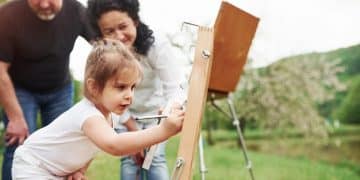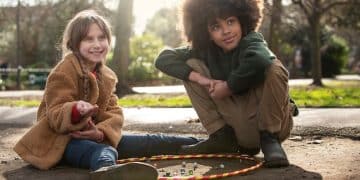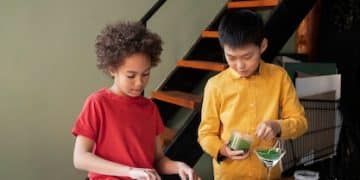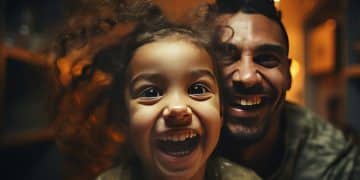Creative arts and crafts for preschoolers: fun ideas
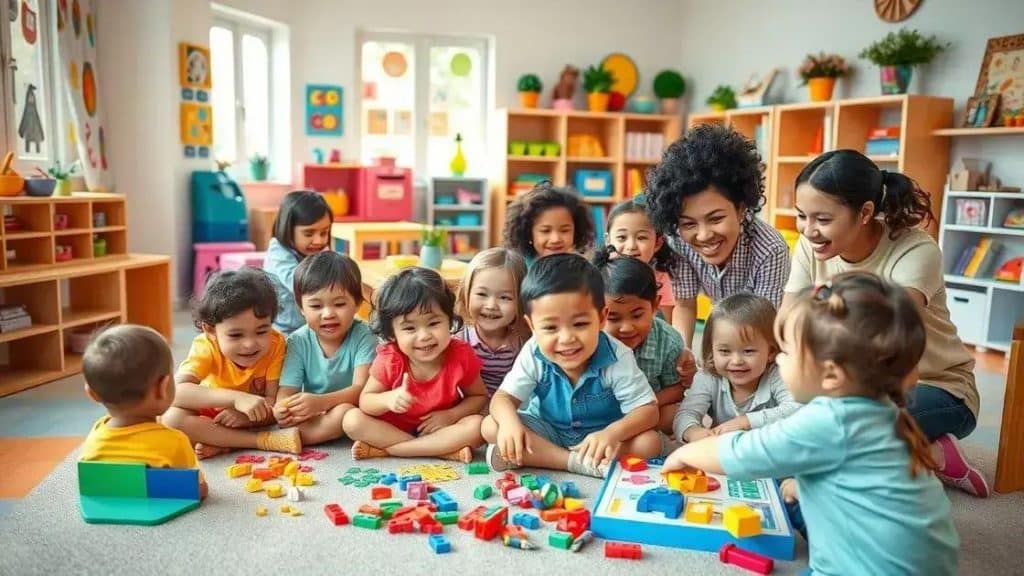
Incorporating nature into creative art projects for preschoolers enhances their artistic expression, promotes environmental appreciation, and allows them to explore textures and ideas using natural materials like leaves and stones.
Creative arts and crafts for preschoolers ignite young imaginations, offering them unique opportunities to learn and express themselves. Have you ever wondered how these activities impact their development?
Exploring the benefits of arts and crafts for preschoolers
Arts and crafts play a crucial role in the development of preschoolers. They not only promote creativity but also enhance various skills that aid in their overall growth.
Enhancing Fine Motor Skills
Engaging in arts and crafts helps young children improve their fine motor skills. As they cut, glue, and draw, they learn to control their hand movements, which is essential for tasks like writing.
- Using scissors helps with grip and control.
- Painting encourages hand-eye coordination.
- Beading improves dexterity and hand strength.
Moreover, these activities allow children to express themselves freely. They can explore colors, shapes, and textures while having fun. This self-expression is vital for their emotional development and confidence.
Encouraging Cognitive Development
Participating in creative arts can also boost cognitive skills. Preschoolers learn to solve problems when figuring out how to complete a project. They practice making decisions regarding colors and materials, fostering their critical thinking.
- Choosing colors for a painting promotes decision-making.
- Creating a craft from various materials teaches resourcefulness.
- Following instructions helps with memory and comprehension.
In addition to cognitive benefits, arts and crafts offer social advantages. When children work together on a project, they learn to share and communicate, reinforcing their social skills.
Fostering Emotional Well-being
Lastly, engaging in arts and crafts can significantly improve the emotional well-being of preschoolers. The process of creating something allows them to express feelings they might not yet have the words for. It provides a gentle outlet for their emotions and helps them to process their experiences.
In summary, the benefits of arts and crafts for preschoolers are profound. From honing fine motor abilities to enhancing cognitive and social skills, these activities are essential in nurturing well-rounded young children. As they explore their creativity, they embark on a journey of self-discovery that lays the foundation for future learning.
Top 10 creative projects for young children
Engaging young children in creative projects not only sparks their imagination but also helps develop essential skills. Here are ten exciting and enjoyable ideas that will inspire creativity in preschoolers.
1. Paper Plate Animals
Using paper plates, children can create adorable animal faces. They can paint or color them and add features like ears and whiskers with construction paper. This project encourages artistic expression and fine motor skills.
2. Nature Collage
Gather leaves, flowers, and small twigs to make a beautiful nature collage. Kids can glue these items onto a piece of cardboard or paper, creating a colorful representation of the outdoors. This activity fosters a love for nature and brings awareness to environmental aspects.
3. Finger Painting
Let children explore with their hands! Finger painting allows preschoolers to use their fingers as brushes, helping them express their emotions. This tactile experience is essential for sensory development.
4. DIY Play Dough
Making play dough at home is simple and fun. Mix flour, salt, water, and food coloring to create this versatile material. Children can use their play dough to shape objects and characters, stimulating their imaginations through open-ended play.
- Encourages creativity and exploration.
- Helps with hand-eye coordination.
- Teaches about measuring ingredients.
5. Craft Stick Puppets
Using craft sticks, kids can create their own puppet characters. They can decorate the sticks with markers, yarn, or fabric. Kids can use these puppets for storytelling, enhancing their verbal skills and creativity.
6. Watercolor Resist Art
Children can draw on watercolor paper with crayons and then paint over it with watercolors. The crayon will resist the paint, creating beautiful designs. This combination of mediums helps develop color awareness.
7. Build a Cardboard Fort
Turn a few cardboard boxes into a fort! Children can decorate and transform these boxes into their special hideaway. Building and imagining stories fosters teamwork and critical thinking.
8. Rock Painting
Collect some smooth rocks and let children paint them with bright colors and patterns. This project not only encourages creativity but also helps children express their thoughts and feelings through art.
9. Sensory Bins
Fill a bin with rice, beans, or sand, and include various toys. This sensory project offers new textures and encourages imaginative play. Children can explore and discover different items, enhancing sensory awareness.
10. Scrap Fabric Art
Using old fabric scraps, children can create unique art pieces by gluing the fabric onto paper. This activity promotes creativity and teaches kids about recycling materials.
Each of these projects allows young children to explore their creativity while developing important skills. These fun activities not only keep them entertained but also contribute to their growth and learning.
Tips for setting up a craft space at home

Setting up a dedicated craft space at home can greatly enhance creativity for preschoolers. A well-organized area encourages kids to explore their artistic side and engage in various activities.
1. Choose a Suitable Location
Select a space in your home that is both convenient and inspiring. Consider a corner of the living room or a designated area in their playroom. Make sure it is well-lit, as good lighting is vital for art projects.
2. Organize Supplies
Keep all craft supplies organized and easily accessible. Use clear bins or drawers labeled by category, such as “paper,” “paints,” and “tools.” This setup helps children learn where to find items and encourages them to clean up after their projects.
- Use shelving units to store materials at child height.
- Keep frequently used items within reach for independent use.
- Rotate supplies periodically to keep things interesting.
A designated craft table can be very helpful too. This temporary or permanent workstation gives children a place to focus on their creative endeavors without distractions.
3. Create an Inspiring Environment
Brighten the area with cheerful decorations, like colorful artwork made by the kids themselves. Having their creations on display boosts their confidence and encourages further creativity.
Additionally, provide various types of materials, such as natural items like leaves and stones, as well as recycled materials. This diversity can stimulate their imagination and inspire unique projects.
4. Include a Cleaning Station
Make art time easier by setting up a cleaning station nearby. Include wipes, a small trash bin, and a place for soaking brushes or tools. Teaching children to clean up after themselves fosters responsibility and respect for their craft space.
Also, consider safety. Ensure that all materials are non-toxic and child-friendly. Supervision is key, especially when using tools or smaller items that could be a choking hazard.
Finally, encourage free expression, but also set a few guidelines. Providing some structure allows children to explore their creativity while maintaining a safe and pleasant environment.
How to encourage artistic expression in preschoolers
Encouraging artistic expression in preschoolers is vital for their creative development. It fosters imagination and helps them communicate their feelings and thoughts through art.
1. Provide Various Art Materials
Offering a range of materials can spark interest and creativity. Include items like crayons, markers, paint, and modeling clay. Each material can inspire new ideas and techniques for young artists.
- Natural materials such as leaves and stones can also be included.
- Recyclable items like cardboard and plastic bottles can be transformed into art projects.
- Different textures in materials help stimulate sensory exploration.
2. Create a Free Space for Creativity
Set up a designated area where children can freely create without fear of making a mess. Cover surfaces with newspaper or a plastic tablecloth to protect them. Allowing them to explore freely enables them to try new things and express themselves without limits.
This environment can encourage children to experiment with colors and shapes. Let them choose what to create and how to use their materials. Providing this freedom fosters confidence and a sense of ownership over their work.
3. Be Supportive and Engaging
Show enthusiasm for their artwork. When they share their creations, ask open-ended questions about their process and ideas. This interaction can help deepen their interest and motivation.
Instead of focusing on the final product, celebrate the efforts and the joy of creating. Encouraging their individual expression allows preschoolers to develop their unique artistic voice.
4. Integrate Art into Daily Activities
Incorporating art into daily routines can encourage creativity. For example, cook together and let children decorate cupcakes with frosting and sprinkles. Playing games like “pretend drawing” can also inspire imaginative thinking.
Reading books with vivid illustrations can spark discussions about colors and styles, enriching their exposure to artistic concepts. Be sure to encourage them to recreate their favorite scenes using their materials.
5. Introduce Art from Various Cultures
Expose preschoolers to art from different cultures and time periods. Show them various artistic styles, like Aboriginal dot painting or Japanese origami. This exposure broadens their understanding and appreciation of art.
Encouraging them to explore and recreate art from different cultures enriches their perspectives and introduces them to diverse forms of expression.
Incorporating nature into creative art projects
Incorporating nature into creative art projects helps preschoolers connect with the environment. It allows children to explore and appreciate the beauty of the world around them.
1. Nature Walks for Inspiration
Taking a nature walk can be an exciting adventure. Encourage children to observe different plants, animals, and natural elements. Have them collect items like leaves, flowers, and small stones to use in their art projects.
2. Using Natural Materials
Integrating natural materials into their creations adds texture and depth to their artwork. Children can use items like:
- Pressed flowers for beautiful collages.
- Twigs and branches for building sculptures.
- Stones for painting or as part of a mosaic.
Using these materials not only enhances creativity but also teaches children about the various elements of nature.
3. Creating Environmental Art
Children can create art that reflects their understanding of nature. Have them draw or paint landscapes, plant trees, or use leaves for printing. This kind of project can help them express their feelings about the environment.
4. Outdoor Art Stations
Setting up an outdoor art station encourages kids to create in natural settings. They can paint on canvases with sunshine on their faces and a breeze in their hair. Being outside can also inspire different kinds of creativity.
Involving nature during art projects can also teach preschoolers about ecology. Discuss the importance of protecting the environment and how art can bring awareness to nature’s beauty. They can even create art pieces that advocate for conservation, making their work meaningful.
Overall, blending nature with art introduces children to the beauty of their surroundings while fostering creativity. With a little inspiration from the outdoors, they can learn to express themselves in imaginative ways.
FAQ – Frequently Asked Questions about Incorporating Nature into Creative Art Projects
How can I get my child to appreciate nature?
Encourage outdoor exploration by taking nature walks and allowing them to collect natural items for art projects. This connection enhances their appreciation for the environment.
What types of natural materials are best for art projects?
Items like leaves, flowers, twigs, and stones can provide diverse textures and colors, sparking creativity and inspiration for young artists.
Why is outdoor art important for preschoolers?
Creating art outdoors fosters a love for nature, offers new sensory experiences, and allows children to draw inspiration directly from their surroundings.
How can I set up a nature-inspired art space at home?
Designate an area with easy access to natural materials, provide tools for outdoor creativity, and encourage freedom of expression in a safe and inspiring environment.
